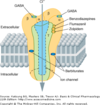Sedatives/Hypnotics/IV Anesthetics Flashcards
(22 cards)
In general, anesthetic drugs work how?
- Enhance inhibitory synaptic activity
- Deminish excitatory activity
Excitatory neurotransmitter and receptor subtypes?
Glutamate (relay neurons all levels and some interneurons)
“Excitatory Receptor types:”
- NMDA (increases cation conductance, especially Ca)
- AMPA (increases cation conductance)
- Kainate (increases cation conductance)
_“Inhibitory Receptor type_s:”
-Metabotropic (Inhibitory (presynaptic); decreaes cation conductance, decreases Ca conductance, decreases cAMP; Excitatory decreases K conductance and increases IP3, DAG
Inhibitory neurotransmitters and receptor types:
Glycine (spinal interneurons and some brainstem interneurons)
-Inhibitory: Increase Cl conductance
GABA (supraspinal and spinal interneurons pre and postsynaptic)
- GABAA: Inhibitory: Increases Cl conductance
- GABAB: Inhibitory (presynaptic): Decreases Ca conductance; Inhibitory (postsynaptic): Increases K conductance
Sedation?
Calming and drowsiness, decreases activity, moderates excitement, calms patient
Hypnosis?
Produces drowsiness and facilitates the onset and maintenance of a state of sleep
Anesthesia?
Global but reversible CNS depression resulting in loss of response to and perception of external stimuli “deafferentation”
Not all agents produce identical state. Collection of changes in behavior and perception anesthetic state is:
- Amnesia
- Immobility to noxious stimuli
- Attenuation of autonomic response to noxious stimuli
- Analgesia
- Unconsciousness
GABAA Receptor
–Major isoform has two α1 two β2 one γ2
–Binding site for GABA between α1 and β2
-Binding site for BZ between α1 and γ2
(Barbiturates bind at alternate site)

Propofol mechanism of action
Potentiation of the chloride current mediated through the GABAA receptor complex
Context-sensitive half-time
Describes the elimination half-time after discontinuation of a continuous infusion as a function of the duration of the infusion.
Major pharmalogical effects of propofol
- Acts as a hypnotic but no analgesia
- Decreases cerebral blood flow and the cerebral metabolic rate of oxygen, which decreases ICP
- Decrease in systemic blood pressure
- Major respiratory depressant and generally produces apnea after an induction dose
- Pain on injection
Mechanism of action of barbiturates?
Combination of enhancement of inhibitory transmission and inhibition of excitatory neurotransmission
- Enhances GABA mediated Cl conductance
- Increases duration of GABA-gated Cl channel opening
- High doses may directly activate Cl channel similar to GABA
- Depresses glutamate binding to AMPA receptor
Major pharmalogical effects of barbiturates?
- Sedation to general anesthesia when bolus
- Cerebral vasoconstrictors and produce decreases in cerebral blood flow, volume, and ICP
- Decrease CRMO2 consumption
- Anticonvulsant activity
- Decrease systemic blood pressure, but not quite as much as propofol
- Respiratory depressants, usually produces apnea at induction
- Accidental intra-arterial injection results in excruciating pain and intense vasoconstriction
Mechanism of action of benzodiazepines
Potentiates GABA receptor inhibition similar to barbiturates, but at a different site

Benzodiazepine metabolism, explain differences and how they relate to duration
All are hepatically metabolized, but diazepam and midazolam have active metabolites that can recirculate
- Half life: D > L > M
- Active metabolites are excreted in the kidney

Vd of benzos
M/D > L
Major pharmalogical effects of benzos
- Decrease arterial blood pressure, cardiac output, and peripheral vascular resistance
- Sometimes increase heart rate
- Depress the ventilatory response to CO2
- Reduce cerebral oxygen consumption, blood flow, ICP, but not as much as barbiturates
- Produces sedation and anxiolytic properties that lead to stupor in higher doses
- No analgesic effect, but reduce the min. alveolar conc. of volatile agents as much as 30%
MOA of ketamine
- Inhibits NMDA and HCN1 channels
- Dissociates sensory impulses from the limbic cortex
- Potentiates glutamate receptor
Pharmalogical effects of ketamine?
- Increases arterial blood pressure, heart rate, and cardiac output
- Central stimulation of sympathetic nervous system and inhibition of NE after it’s release
- Increases pulmonary arterial pressure and myocardial work
- Racemic mixture is good bronchodilator and could be used in asthmatics
- Increases cerebral blood flow, and ICP but if used with benzo and controlled ventillation the effects are diminished
Doxapram uses and pharmalogical effects?
Doxapram is a respiratory and CNS stimulant for depression secondary to anesthesia
- Stimulates respiration through action on respiratory center in medulla or indirectly on peripheral carotid chemoreceptors
- Stimulates hypoxic drive (temporary effect)
Adverse effects: seizures, agitation, confusion, tachycardia, arrhythmia, nausea and vomitting
Dosing: 0.5-1 mg/kg
Onset: 1 min Duration: 5-10 min
MAX DOSE: 4mg/kg
Malignant hyperthermia
1:15,000 peds 1:40,000 adults
Usually upon induction, acute hypermetabolic state that causes uncontrolled release of intracellular Ca in skeletal muscle
Signs and symptoms:
- Profound MMR, tachycardia, hypercarbia
- Hypermetabolism, CO2 production, O2 consumption, metabollic acidosis, cyanosis
- Muscle damage, CK, K, Na, PO4, myoglobinemia/urea
- Rigidity
How do you manage MH?
- Turn off inhaled agent and succinylcholine
- Hyperventilate
- Administer NaHCO3
- Mix dantrolene and give 2.5mg/kg IV
- Cooling measures
- Inotrope, pressor, antiarrhythmic as needed
- Treat hyperkalemia
Dantrolene
Binds to Ryr1 receptor of Ca channel and inhibits Ca release from SR
Dosing:
- Reconstitute with sterile water
- 20mg/60mL water
- 2.5mg/kg/5min until episode terminated
- MAX 10mg/kg
1mg/kg every 6 hours next 24 to 48 hours


